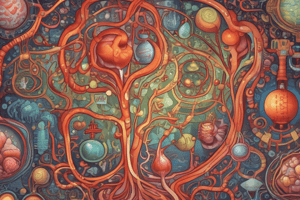Podcast
Questions and Answers
What is metabolism?
What is metabolism?
The chemical reactions in the cell that obtain/utilize energy, breakdown compounds to obtain building blocks for synthesis, or conduct synthesis of cellular compounds & structures.
What is the need for metabolism?
What is the need for metabolism?
Precursor molecules and energy (electron source/flow).
What is anabolism?
What is anabolism?
Synthesis.
What is catabolism?
What is catabolism?
What are oxidation-reduction cycles?
What are oxidation-reduction cycles?
What are electron carriers?
What are electron carriers?
What is ATP?
What is ATP?
What are enzymes?
What are enzymes?
What is a substrate?
What is a substrate?
What effects enzymes?
What effects enzymes?
What is fermentation?
What is fermentation?
The primary structure of proteins is the sequence of __________.
The primary structure of proteins is the sequence of __________.
The process by which glucose is broken down in the Krebs cycle produces __________ ATPs.
The process by which glucose is broken down in the Krebs cycle produces __________ ATPs.
Which of the following are electron carriers?
Which of the following are electron carriers?
Which of the following is a result of enzyme activity?
Which of the following is a result of enzyme activity?
What do carbohydrates catabolism involve?
What do carbohydrates catabolism involve?
What is feedback inhibition?
What is feedback inhibition?
Which types of metabolic pathways produce sugars from noncarbohydrate molecules?
Which types of metabolic pathways produce sugars from noncarbohydrate molecules?
Study Notes
Metabolism
- Defined as the sum of chemical reactions within a cell to obtain/utilize energy, synthesize cellular components, and break down compounds for building blocks.
- Requires precursor molecules and energy sources for electron flow.
Anabolism and Catabolism
- Anabolism involves synthesis processes within the cell.
- Catabolism refers to the breakdown of compounds to harvest energy and building blocks.
Electron Transport and Carriers
- Oxidation-Reduction cycles involve the movement of electrons, often carried by hydrogen (H-).
- Key electron carriers include NAD (Nicotinamide Adenine Dinucleotide), NADP (Nicotinamide Adenine Dinucleotide Phosphate), and FAD (Flavin Adenine Dinucleotide).
ATP Functionality
- ATP serves as the primary energy currency of the cell, fueling synthesis, active transport, and cellular movement.
Enzyme Structure and Function
- Enzymes can exist as standalone or as part of holoenzymes, which consist of an apoenzyme and cofactors.
- Enzymatic activity depends on structural integrity, influenced by pH and temperature.
Enzyme Inhibition
- Competitive Inhibition involves the inhibitor binding to the active site, impacting substrate saturation without denaturing the enzyme.
- Noncompetitive Inhibition occurs when allosteric sites are occupied, altering enzyme activity without interfering with the active site.
- Feedback Inhibition involves end products returning to inhibit upstream reactions.
Fermentation and Respiration
- Carbohydrate catabolism processes include aerobic respiration—which fully converts glucose to CO2 and H2O—and fermentation, which produces lactic acid or ethanol with lesser ATP yield.
- Different fermentation products include lactic acid (yogurt), ethanol (beer, wine), and carbon dioxide (Swiss cheese).
Cellular Respiration Pathways
- Key metabolic pathways include glycolysis, the Krebs cycle, and the electron transport chain.
- NADPH plays a crucial role in synthesizing nucleotides, steroids, and fatty acids.
Amino Acid and Nucleotide Biosynthesis
- Amino acids are synthesized from precursor molecules derived from glycolysis, the Krebs cycle, and the Pentose Phosphate Pathway.
- Nucleotides consist of a 5C sugar, a phosphate group, and a nitrogenous base produced from these pathways.
Regulation of Metabolism
- Cellular metabolism is regulated based on substrate availability and gene expression.
- Both enzyme control and cellular transport mechanisms are essential in metabolic regulation, with transport proteins modulating substrate concentrations.
Basic Precursor Metabolites
- Twelve precursor metabolites serve as building blocks for macromolecules and are derived from glycolysis and the Krebs cycle.
- Specific metabolites are linked to sugar, fatty acids, and amino acid synthesis.
Lipid and Protein Catabolism
- Lipid catabolism occurs through hydrolysis and beta oxidation, while protein catabolism is utilized when glucose and fats are depleted, relying on amino acid breakdown.
Amphibolic Pathways
- Amphibolic reactions are capable of functioning in both catabolic and anabolic directions, providing metabolic flexibility (e.g., lipids).
Importance of Fermentation Products
- Fermentation products serve practical purposes in food production (cheese, yogurt) and can be used to identify microbial species based on the specific products they generate.
Studying That Suits You
Use AI to generate personalized quizzes and flashcards to suit your learning preferences.
Description
Test your understanding of key concepts in metabolism through these flashcards based on Chapter 5 of Microbiology. This quiz covers essential terms such as metabolism, anabolism, and catabolism, providing definitions and explanations for better comprehension.



